Titanfall hands-on: jetpacks, rocket attacks and the many modes of mech warfare

Titanfall's beta is bearing down on us like an oversized mech dropping from the sky. I recently spent some time with Respawn Entertainment's sci-fi FPS, and got to try out the three game modes that will debut in its pre-launch test. What I discovered was a fun, brash AAA shooter, but one that also offered a surprising amount of depth around the instant gratification of stompy bots and double-jumping soldiers.
Here is my round-up of what you can do in the game, and what its multiplayer modes reveal about the complexities and moment-to-moment decision making that players will encounter.
Attrition
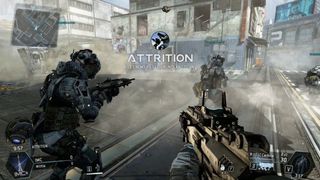
This is Titanfall's version of team deathmatch, in which two teams collect 'Attrition' points by killing 'Pilots' (the game's term for other players), AI grunts and Titans. It's the most immediate of the modes: putting you in combat faster and more frequently than the other, more objective oriented game types.
It was here I got a feel for the character control. Titanfall is recognisably a descendant of the modern military FPS – it's got the spirit of Call of Duty running through its pace, weapon feel and progression system. There are differences, though, and its these that make the game feel fresh and exciting after multiple CoD sequels and the increasing homogenisation of the genre.
The most striking is how nimble Pilots feel. They can wall-run, double-jump and mantle up ledges, giving a new feel to the crisp, urban environments. Windows and balconies aren't just an invitation for camping snipers, but another route through buildings. Pleasingly, there are no canned animations to line you up for ledge grabs and other free-running tricks, meaning the flow of movement is always responsive and natural. Also that, if you misalign a head-first jump into a small window, you'll instead face-plant into the wall and look stupid.
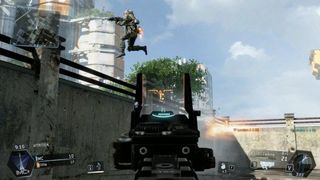
The other big difference is in your survivability. Call of Duty is a battle of opportunism, where, in one-on-one firefights, you're putting down those that you catch unawares, and being put down by those that catch you. Titanfall's pilots aren't bullet sponges, but they are able to take some damage while quickly fleeing danger. It gives you the chance to escape an attack, reassess the battlefield, and then re-initiate on your own terms.
After a few minutes, the Titans arrive. Rather than earn them through points, these giant mechs are on a countdown – their timer decreasing as you do damage and kill enemies. They're a big, stompy reward – a blunt tool for smashing about, building up more kills, before enough enemy players and opposing Titans take you down. Take out a Titan's shield and health, and they're “Doomed”, able to let off a final few rounds before they're fully destroyed. This lets players eject – shooting up into the sky for an aerial view of the map, before jumping into the nearest combat hotspot.
The biggest gaming news, reviews and hardware deals
Keep up to date with the most important stories and the best deals, as picked by the PC Gamer team.
Hardpoint
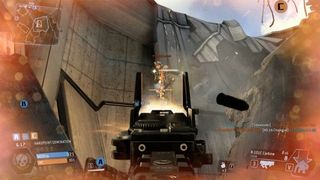
If Attrition is uncomplicated action, Hardpoint feels like proper Titanfall. It's a point capture mode, where players must fight and hold three bases around the map. As such, it's an immediately familiar objective, but one that exposes the depth of the game's combat options.
Each player has a limited cloaking ability, masking them in a translucent sheen. Rather than charging towards the objective, it allows you to take a moment to plan your attack. I'd frequently cloak, drop into the capture area, scout for potential threats, before opening fire from the most beneficial vantage points. It's a small thing, but makes a big difference in your ability to upset a competent defence.
The openness and verticality of buildings is also a factor. Capturing or defending a point is unnerving – with multiple entrances and points of attack. Again, the cloak becomes a factor. Do you use it straight away, hoping that your opponent misses your tell-tale spectral warping, or do you wait until the last moment, using your cover to ensure you're not killed seconds before the capture? As soon as you fire, the cloak is disabled, and you'll need to wait before it can be reactivated. Perfecting the timing of its use is a crucial skill to lone-wolf attacks.
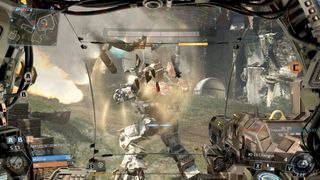
Through the minimap, you'll get an idea of enemy positions, but even then, the multiple floors of buildings make it possible to bypass an opponent. To an extent, this is the reason for the AI grunts. Before the Titans start to appear, providing players with an obvious target, it's easy to miss the opposing six players. In Attrition especially, the grunts feel like a way to provide a short burst of conflict to occupy you between the more tense fights against other players. They're cannon-fodder in the most basic sense – the game relying on the satisfying feel of the weapons to provide a short hit of entertainment between more involved firefights. In Hardpoint, where players are naturally drawn to objectives, the grunts felt almost extraneous – although, having played only a couple of games in the mode, it's too early to dismiss them entirely.
The objective-based nature of Hardpoint meant the Titans naturally took on a different role. No longer a tool of brief, childlike destruction; they become sentinels, patrolling bases from an assault against organised attacks and opposing mechs. Often I found the best tactic for dealing with Titans was to go in small and quiet, slipping past into the base, then popping out to do chunks of damage while they're distracted by bigger threats. I got plenty of thrills from securing an objective while also taunting a frustrated mech pilot.
Last Titan Standing
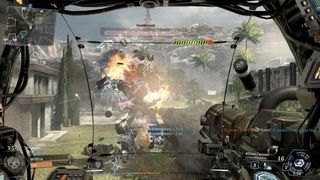
This was a new mode I was shown, in which every player starts inside a Titan. It was also my least favourite of the three game modes, mostly because every player starts inside a Titan. As the title implies, your job is to be the team with the most Titans alive at the end of the round, placing a much greater importance on keeping them intact.
The problem is that, when made the focus of the round, Titans feel restrictive to pilot. It's not that they're slow – especially in relation to other mech shooters – but you're far less manoeuvrable than when you're not strapped into a giant metal death machine. When piloting a Titan, it's still possible to sprint, and also to use a limited dash move to quickly strafe threats. What you can't ever do is leave the ground, which can feel limiting after a few rounds of wall-running freedom.
You can leave your Titan at any point, at which point it will either stand guard or follow – bounding after you like an excitable giant puppy. In Last Titan Standing, though, this seems inadvisable. I was regularly being hunted by two or three opposing Titans, and while quickly ejecting to harass one is a legitimatise tactic, letting a Titan auto-attack multiple enemies is a sure route to destruction.
Despite this, Last Titan Standing justifies its inclusion by functioning almost as a training mode for high-level Titan play. It gives you the space to get a feel for the different weapons, and teaches the surprising survivability that the machines are capable of. In the other mode, Titans function almost as a quick reward for good play, meaning I never felt too invested in keeping them alive. But when survival is mandatory, the depth of Titan combat comes to the fore.
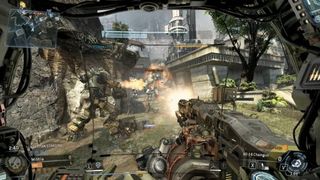
Primarily, this centres around the limited force field, which shields your Titan, and catches any bullets fired its way. When you disable the field, those bullets – really huge explosive shells – are fired at your target, potentially causing huge damage. That's unless they've deployed their own force field to catch anything flung their way. There are plenty of these back-and-forth moments, and they ensure some low-level tactical satisfaction for successfully out-thinking an opponent.
As much as I enjoyed the mix of fast-paced shooting and freedom of movement, it was impossible to tell how well Titanfall will fare as a lasting FPS alternative. There is a progression system, offering new classes, weapons, and the ability to customise both, but the depth of its options wasn't immediately apparent. The game also offered “Burn” cards – one use bonuses that are earned during regular play. These offered minor buffs or alternate weapons to be used during a round, but their effect during our demo was hard to discern.
Long term questions aside, there's plenty to appreciate. Even in the three-hour demo, the tactics and preferences of the players made a significant impact on each round. Hopefully the upcoming beta will reveal the scope of options that the full game will offer. And, even if it doesn't, it will still let people drop a massively armed mech from space. Sometimes it's the big things in life that matter.

Phil has been writing for PC Gamer for nearly a decade, starting out as a freelance writer covering everything from free games to MMOs. He eventually joined full-time as a news writer, before moving to the magazine to review immersive sims, RPGs and Hitman games. Now he leads PC Gamer's UK team, but still sometimes finds the time to write about his ongoing obsessions with Destiny 2, GTA Online and Apex Legends. When he's not levelling up battle passes, he's checking out the latest tactics game or dipping back into Guild Wars 2. He's largely responsible for the whole Tub Geralt thing, but still isn't sorry.
Most Popular

